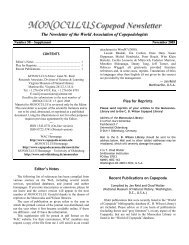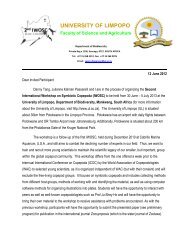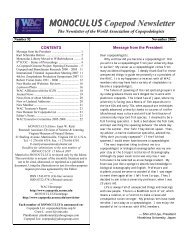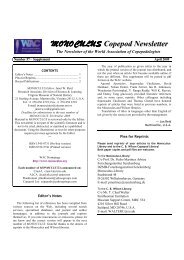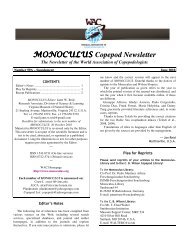MONOCULUS Copepod Newsletter - World Association of ...
MONOCULUS Copepod Newsletter - World Association of ...
MONOCULUS Copepod Newsletter - World Association of ...
You also want an ePaper? Increase the reach of your titles
YUMPU automatically turns print PDFs into web optimized ePapers that Google loves.
Report on the<br />
“13th International Mei<strong>of</strong>auna Conference”<br />
(THIRIMCO, 29 July - 3 August 2007, Recife)<br />
Some 135 meiobenthologists from 22 countries<br />
participated in THIRIMCO, the thirteenth meeting <strong>of</strong> the<br />
International <strong>Association</strong> <strong>of</strong> Meiobenthologists, held at the<br />
Recife Palace Hotel in Pernambuco, Brazil. Because, as with<br />
the ICOCs, the IAM conferences occur every three years,<br />
this represented the 39th anniversary <strong>of</strong> meetings <strong>of</strong> this<br />
association. The dominant themes reflected the primarily<br />
marine-community-ecological interests <strong>of</strong> the participants,<br />
with some studies on freshwater faunas, and a large number<br />
<strong>of</strong> taxonomic reports as well. Talks and posters on<br />
nematodes and copepods predominated, but gastrotrichs,<br />
gnathostomulids, halacarids, kinorhynchs, loriciferans,<br />
opisthobranchs, platyhelminths, polychaetes, rotifers,<br />
sipunculans, and tardigrades were also represented among<br />
the approximately 165 presentations.<br />
Prominent themes were the mei<strong>of</strong>auna <strong>of</strong> shallow-water<br />
habitats such as mangrove forests, seagrass beds, mudflats,<br />
and sandy beaches; deep-sea habitats, including<br />
hydrothermal vents; and effects <strong>of</strong> pollution. Impressive<br />
products from the MANUELA Project (Meiobenthic and<br />
Nematode Biodiversity: Unravelling Ecological and<br />
Latitudinal Aspects – http://nemys.ugent.be), a collaborative<br />
effort within the EU - MarBEF Network, now include an<br />
integrated dataset, and NeMys (an online nematode<br />
identification and taxonomical tool). Several presentations<br />
used information from MANUELA to reveal distributional<br />
and community patterns.<br />
It was obvious that international cooperative projects<br />
continue to foster rapid progress in mei<strong>of</strong>auna studies, in<br />
particular in Brazil. In addition to the large and productive<br />
group <strong>of</strong> researchers at the Federal University <strong>of</strong><br />
Pernambuco (UFPE) and the Rural Federal University <strong>of</strong><br />
Pernambuco (UFRPE), participants came from 15 other<br />
universities and institutions in nine coastal states <strong>of</strong> the<br />
country. Thanks to the organizers for providing a stimulating<br />
meeting and inimitable Brazilian hospitality.<br />
― Jan Reid<br />
Virginia Museum <strong>of</strong> Natural History, Martinsville, U.S.A.<br />
Current <strong>Copepod</strong> Editors for Zootaxa<br />
Tomislav Karanovic and Danny Tang are currently<br />
copepod subject editors for Zootaxa. They have volunteered<br />
for this role while Genefor Walker-Smith is on maternity<br />
leave.<br />
― Danny Tang<br />
4<br />
What do <strong>Copepod</strong>s look like inside<br />
ecosystem models?<br />
Ever looked at a model’s insides, I mean really on the<br />
insides <strong>of</strong> it, the hieroglyphic equations, alien parameter<br />
names that never follow biological sense, the terminology<br />
that sounds like a different language? And if your facial<br />
expression was covered with all the incomprehension,<br />
confusion and self-doubt as was mine, then you are<br />
definitely not a modeler. And if you have never stared at the<br />
guts <strong>of</strong> a model, then the reaction <strong>of</strong> your colleagues around<br />
you may not have inspired you to do so either.<br />
So! Not all process scientists have what it takes to digest<br />
the gritty details <strong>of</strong> the current global 3D models. Frequently<br />
it is even a challenge understanding modeled processes that<br />
one might be an expert at. One consolation must be that<br />
modelers have to be just as phobic about Eppendorf test<br />
tubes and latex gloves. Otherwise they wouldn’t be<br />
performing their experiments virtually, right!<br />
Whether we like it or not, whether we want to get<br />
involved or not, global biogeochemistry models are too<br />
powerful a tool to ignore, even if there are many gaps to fill<br />
and parameters to fix. They are an invaluable predictive,<br />
diagnostic and research grant-winning tool, especially in the<br />
age <strong>of</strong> global climate change.<br />
A Key Trophic Link<br />
A recent symposium on parameterization <strong>of</strong> global ocean<br />
ecosystem models (www.eur-oceans.eu/cadiz) reconfirmed<br />
that ecosystem models have many problems, and essential<br />
processes are oversimplified, misrepresented or just plain<br />
wrong – a frequent concern <strong>of</strong> process scientists. This seems<br />
to be even more the case at one key part <strong>of</strong> the food chain,<br />
the mid-trophic levels, or the domain <strong>of</strong> zooplankton.



